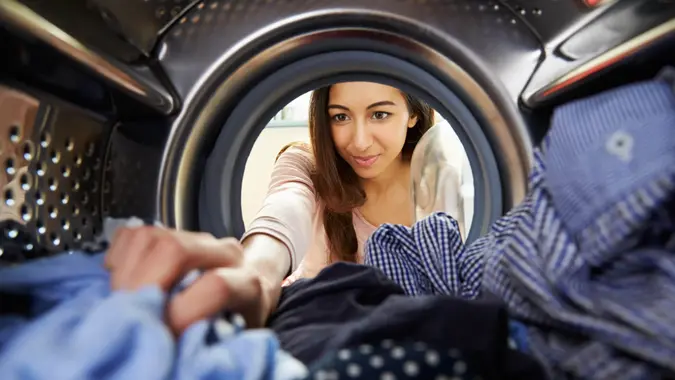
monkeybusinessimages / Getty Images/iStockphoto
Utilities such as water, gas and electricity can be quite costly. For example, according to the U.S. Energy Information Administration, the average monthly electricity bill in the first three months of this year was $133.
See: How To Save $200 on Your Grocery Bill Every Month
If utility costs wreak havoc on your wallet, consider replacing these six appliances with energy-efficient models. They can help you lower your utility bills quickly.
1. Refrigerator
Refrigerators can be major energy hogs, especially old ones. The U.S. Department of Energy estimates that old refrigerators use up to 35% more electricity than newer, more efficient models. Though replacing kitchen appliances can be expensive, it makes sense to do so if your older one needs repairs.
Look for a new refrigerator with the Energy Star label to make the most of your savings. Energy Star refrigerators are about 9% more efficient than other models, saving you more than $220 over their 12-year lifespan. For extra savings, give up the in-door ice and water dispenser. This feature is convenient, but you’ll pay extra for it, increasing your electricity costs.
2. Washing Machine
According to the Energy Star website, the average family in the U.S. washes approximately 300 loads of clothing per year. If you have an older, top-loading washing machine, you may pay more for electricity and water than you’d like. Switching to a front-loading washer with the Energy Star label can yield significant savings.
Front-loading Energy Star washers use 45% less energy and up to 50% less water than their top-loading counterparts. For maximum savings, look for one with a high Integrated Modified Energy Factor score, which indicates maximum energy efficiency.
3. Dryer
Clothes dryers aren’t quite the same utility hogs as washers, but they can still dramatically impact your electricity bill. If you’re using an older model, it likely doesn’t have the same efficiency as newer dryers with an Energy Star label. Energy Star dryers have unique features that can cut your electricity costs, such as sensors that automatically end the cycle when your clothes are dry.
Purchasing an Energy Star dryer with a heat pump can save you additional money. Heat pump dryers consume up to 30% less energy than traditional clothes dryers. Keep in mind that a heat pump dryer may cost a little more upfront, but you’ll save money in the long run.
4. Dishwasher
Dishwashers save you time by eliminating the need for hand-washing cooking utensils and dishes. However, older models are often inefficient, using lots of water and electricity to wash and dry your dishes. If your dishwasher is over 10 years old, consider replacing it with a newer model with an Energy Star label.
Energy Star dishwashers cost an average of $55 yearly to run. They offer various money-saving features, such as auto-sensing, which determines how much water is necessary to clean your dishes. You can save additional cash by turning off the heat and hand drying instead.
5. Microwave
As far as kitchen appliances go, having a microwave is pretty standard. You likely use your microwave to reheat food and drinks. However, you may not realize that microwaves use up to 80% less energy than conventional ovens — making them a great way to save money on your electricity bill.
Although there are no Energy Star microwaves, they all use about the same amount of energy. You can pick one that suits your budget and includes the features you need. The more you rely on your microwave rather than your oven, the more cash you’ll keep in your wallet.
6. Electric Kettle
Electric kettles are popular overseas, particularly in Europe and Asia. However, they’re not yet a staple in U.S. households. Electric kettles help boil water quickly, which you can use for instant coffee, tea or anything else that requires hot water.
Using an electric kettle to boil water is cheaper and faster than the traditional stovetop. If you switch to instant coffee rather than using a Keurig or similar coffee maker, you’ll also spend less on K-Cup pods or espresso pods.
Final Take
If your utility bills are higher than you’d like, consider the appliances you’re currently using. Inefficient washers, dryers and refrigerators can all increase your electricity costs. Replacing them with Energy Star-approved models can help you lower your expenses. Other tricks, such as using your ceiling fans instead of the air conditioning, can save you even more money.
FAQ
- Which appliances use the least electricity?
- It depends. Smaller appliances, such as dishwashers, typically use less electricity than larger ones. But your usage time and the product’s age will impact electricity costs.
- What appliances should I turn off to save energy?
- Some appliances need to stay plugged in — think kitchen appliances, such as your refrigerator and freezer, which are necessary for food safety, and your oven and stove, which may be hardwired into the wall.
- But apart from these, whenever you’re not using an appliance, turn it off. There’s no need to keep it running if it’s not in use. Another reason to consider unplugging your appliances is that most devices continue to use some standby power when they’re plugged in.
- What device can help you save money on your electric bill?
- Investing in an energy monitoring system can help you determine where you’re using the most electricity. Energy monitoring systems monitor all the power in your house, and you can review your usage on your computer or smartphone to decide where you can make the most impactful energy-saving changes.
- Does unplugging appliances save money on your electric bill?
- Yes. Some appliances continue to source energy even when they’re turned off. Unplug them to save on your electric bill.
Our in-house research team and on-site financial experts work together to create content that’s accurate, impartial, and up to date. We fact-check every single statistic, quote and fact using trusted primary resources to make sure the information we provide is correct. You can learn more about GOBankingRates’ processes and standards in our editorial policy.


